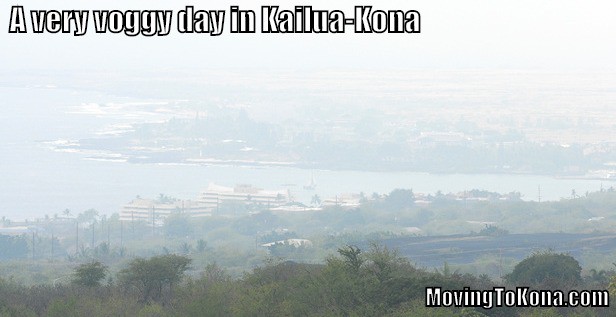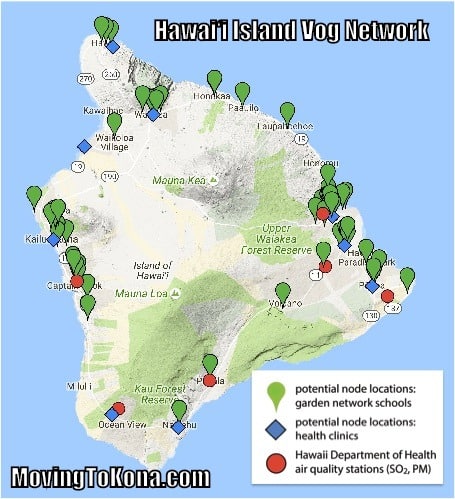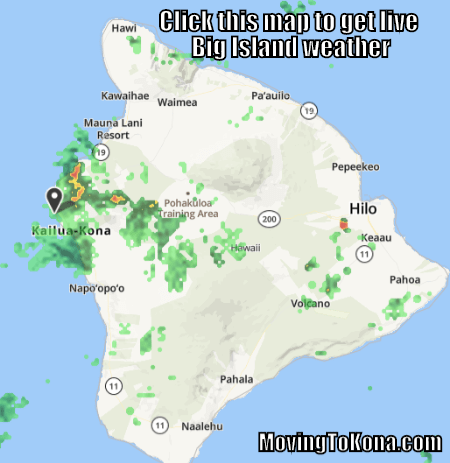Kona Weather: Vog Information
Just What Is Vog? The term ‘vog’ refers to the hazy air pollution caused by the volcanic emissions from Kīlauea volcano, which are primarily water vapor (H2O), carbon dioxide (CO2), and sulfur dioxide (SO2) gas.
In layman’s terms, vog is volcano emissions plus fog.
If you are visiting from Southern California, a poor day of vog in Kona looks like San Bernardino air quality on a good day. It doesn’t happen often, actually rarely, except when Pele (she who shapes the land) is showing who really runs the Big Island.
Before I go any further, if you scan down this page, you might be thinking, “Gosh, that’s a lot of information on vog. Do I really need all that?” Well, the answer is you don’t need all this vog information – until you do need it. If you become exposed to heavy vog, you will need to be aware of this vog information.
Thanks for sharing this with a friend. Visit us on Facebook – Moving To Kona.
Vog Air Quality Data: The airborne concentrations of SO2 gas and PM2.5 (fine particles) are measured within the Hawaiʻi Volcanoes National Park and across the Island of Hawai’i using Hawai‘i Island Vog Network.
Where Is Vog The Worst? The quick answer – it depends. The closer to the Kīlauea volcano the more likely you are to be impacted by vog. The distribution of volcanic pollution and ash on Hawai‘i island is controlled by wind speed and direction. Prevailing northeasterly trade winds blow volcanic emissions to the southwest, where they wrap around the southern part of the island, and are trapped by daytime onshore and nighttime offshore sea breezes along the Kona coast. Air quality north of Kailua-Kona is less frequently impacted by volcanic pollution under these conditions.
When trade winds are absent, volcanic vog pollution may affect East Hawai‘i, the entire Big Island, or even the entire State of Hawaii.
In any location, vog concentrations are primarily dependent on the amount of volcanic emissions, the distance away from the source vents, and the wind direction and speed on a given day. The most common wind patterns in the Hawaiian Islands are the northeasterly trade winds. Consequently, the areas southwest of Kīlauea are most frequently affected by vog on Hawaiʻi Island. When trade winds are absent, which occurs most often during the winter months, east Hawaiʻi, the entire island, or the entire state can be impacted by vog.
Kona gets ‘wrap-around’ vog. The wind blows the vog and then the weather pattern sometimes sends vog up the east coast of the Big Island.
Vog Alerts: You can visit the County of Hawai’i to sign up for Big Island civil defense messages and alerts. Plan on spending a few minutes to register…
Also, you can see satellite real-time vog flow via NOAA.
What Is The Hawai‘i Island Vog Network? The Massachusetts Institute of Technology Department of Civil and Environmental Engineering has partnered with The Kohala Center to launch the Hawai‘i Island Vog Network. A state-of-the-art network of “vog trackers”—air quality sensor nodes capable of measuring levels of volcanic air pollutants—will be installed and pilot-tested at 30 to 40 sites around Hawai‘i Island. Below is the planned vog monitoring network.
Local air quality, and the impacts of vog, are currently measured by the Hawaii State Department of Health as well as the U.S. National Park Service and U.S. Geological Survey [data]. While the primary purpose of this project is to test and fine-tune these low-cost sensors before making them available to other communities around the world impacted by volcanic emissions, the network will provide Hawai‘i Island community members, educators, and researchers with access to measurements of local air quality in real time.
What Are The Possible Health Effects Of Vog? The on-going volcanic activity at the summit and east rift zone of Kīlauea volcano, on Hawaiʻi Island, creates the potential for volcanic airborne health hazards to residents and visitors. At the levels of volcanic emissions occurring over recent years, individuals with pre-existing respiratory conditions are the primary group at risk of experiencing health effects from vog exposures, but healthy people may also experience symptoms.
It is very important to listen to your own body and take measures to protect yourself if you feel your health is being affected by vog. The ‘sensitive groups’ most likely to experience health impacts include people with asthma or other respiratory conditions, people with cardiovascular disease, older adults, infants and children and new or expectant mothers.
If you have asthma or other respiratory conditions, keep your medication available and use as prescribed.
How To Reduce Personal Exposure to Vog: Limit strenuous activities: Outdoor exercise or exertion increases your chances of being affected by SO2 gas and/or PM2.5 . When vog levels are elevated, reduce strenuous activity, if possible.
What To Do In A Vog Emergency: Stay indoors – when vog levels rise, go indoors and close all doors and windows to the outside and, if possible, seal obvious gaps under doors or around windows. Alternatively, consider visiting indoor areas that are better-sealed and/or have air-conditioning (i.e., commercial buildings or businesses).
Worst case, leave the vog impacted area. On the Big Island, that generally means driving north. Consult with a live weather map from Weather.com. Keep your car windows closed.
(Umm, I used this image because it shows rain in Kailua Kona – most people don’t believe that it rains here)
Reduce Indoor Vog With An Air Cleaner: If doors and windows in your house, or in one room of it, can be closed, the use of an appropriate air-cleaning device can help reduce the levels of both SO2 and PM2.5 (if you live near the source vents), or just PM2.5 (if you live farther from the vents).
- True-HEPA filter captures 99.97% of airborne pollutants; dust mites, pet dander, pollen and other allergens as small as 0.3 microns.
- Washable AOC™ Carbon Filter, made from activated carbon granulars for removal of household odors.
- PlasmaWave acts as a permanent filter to safely break down odor, allergens, chemical vapors and other pollutants – with no harmful ozone.
- Smart Sensors gauge the air and our Auto Mode adjusts the fan to filter the air as needed; with a sleep mode for silent night-time operation.
- CADR rated for 360 sq. ft. room size. Suitable for medium and large rooms; kids bedrooms, family rooms and kitchens.
More Vog Information (Can you believe there are so many resources?):
- Vog forecasts for the Big Island and State.
- The Vog Measurement and Prediction Project (VMAP) provides real-time vog forecasts
- Volcano National Park Graphical Forecast
- Ashfall forecast for a hypothetical eruption.
Visit us on Facebook – Moving To Kona.




